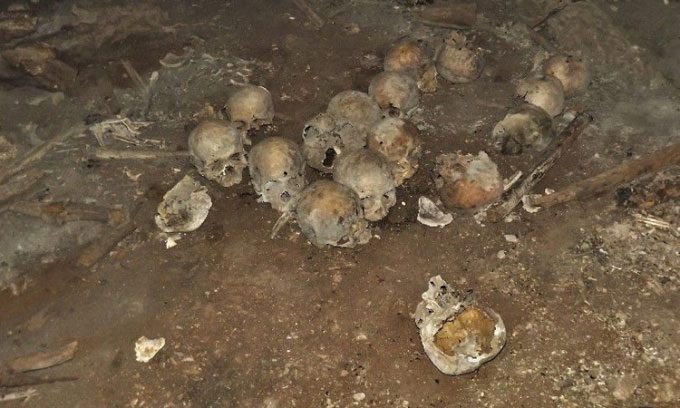Approximately 150 toothless skulls discovered in a cave in Chiapas likely belonged to victims of ancient sacrificial rituals.
In 2012, when around 150 human skulls were found in a cave in Chiapas, Mexico, local police initially suspected it was a crime scene. However, research later revealed that these individuals did not die recently, as reported by Live Science on April 30. Instead, the skulls date back to the pre-Columbian era, approximately between 900 and 1200 AD, and are likely victims of sacrificial rituals.

Approximately 150 human skulls discovered in a cave in Chiapas, Mexico in 2021. (Photo: National Institute of Anthropology and History, Mexico)
After the discovery, experts removed the bones from the cave and transported them to the capital, Tuxtla Gutiérrez, in Chiapas. Here, police and the National Institute of Anthropology and History (INAH) collaborated on the investigation. The skulls were found in an area notorious for violence and human trafficking. Additionally, there were no clear signs indicating that the deceased belonged to the pre-Columbian period.
Upon analysis, the INAH research team determined that the skulls are over 1,000 years old, primarily belonging to adult women, with the exception of three infant skulls. Furthermore, none of the skulls had teeth.
This suggests that a tzompantli or “skull rack” once existed in the cave, according to Javier Montes de Paz, an anthropologist at INAH who helped date the skulls. The reason for this conclusion is that the bones in the cave are mostly skulls or fragments of skulls, with no complete skeletons found.
A tzompantli is a wooden structure used by the Aztecs and other cultures in ancient Mesoamerica to display the skulls of sacrificial victims. Their heads were pierced through the temples and placed on stakes, resembling beads on an abacus, according to scholar Juanita Garciagodoy, who previously taught in the Spanish department at Macalester College. The team of scientists found traces of wooden stakes alongside the skulls, providing further evidence of a tzompantli.
This is not the first time a tzompantli has been discovered in Chiapas. In the 1980s, 124 skulls— all toothless— were found in the Banquetas cave. Similarly, in 1993, during the exploration of the Devil’s Tapesco cave, five skulls were found believed to have been placed on a wooden frame. Montes de Paz emphasized the need for continued archaeological research in the area and stated that if individuals discover such sites, they should immediately contact the authorities or INAH.




















































